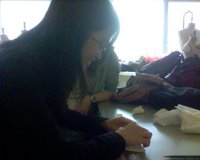With more than 400 design programs in Chinese schools, Asian design education is undergoing its own revolution
Pay a visit to the Asian Lifestyle Lab on the tropical expanse of Hong Kong known as Kowloon. Housed within Hong Kong Polytechnic's School of Design, students in the lab are researching how people use rice cookers, what they need from tennis shoes, and how to create eyeglasses that fit well atop the bridge of an Asian nose. The four-year-old program is attracting interest from a growing number of global companies like Philips Design, Yahoo! (YHOO ), Nike (NKE ), and Reebok.
Design is on the rise at HK Polytechnic and other Asian universities as academia rushes to respond to China's dictate that innovation must be a priority. The country is trying to move from "Made in China" to "Designed in China," and many believe that design education is a part of that equation. There are more than 400 programs in China alone right now, with an estimated 10,000 designers graduating every year.
The country is making significant investments. In 2004, HK Polytechnic hired Lorraine Justice, formerly head of Georgia Tech's industrial design program, who has 20 years experience teaching American design. Justice was responsible for co-organizing the First China-USA Industrial Design Conference in Beijing. She now heads a design research program as fresh as any program in the U.S., with multidisciplinary partnerships, sponsorship from global companies, and a focus on ethnographic research. Last year, the school embarked on a partnership with the business school to award joint master's degrees to 30 students. And this year, mainland China is bringing the program to Beijing's Tsinghua University.
INQUISITIVE ADVANTAGE. However, even as schools pop up, few have evolved from a classical focus on aesthetics and products to embrace design thinking and research of the nature that HK Polytechnic promotes.
The best Asian schools provide students with first-rate technical skills, but their graduates leave without the ability to work across disciplines or to use design strategically. They're not about to do much business model innovation, for example. Much of this may be attributed to Asian education systems from primary school on, which still tend to stress repetition over independent thinking. Says Justice: "The U.S. has a quick advantage. We grow up asking questions. This carries over into our advanced education. They don't have that in China, and it will take them years to develop that mindset."
Nevertheless, that U.S. advantage won't last long. Already schools in China, Korea, Japan, and even India are pulling together design concepts in new ways to land spots on our Global BusinessWeek Design Schools list [
LINK TO LIST]. As the Asian schools' competencies grow, a few U.S. design schools are partnering with them. At Oakland (Calif.)-based California College of the Arts, Yves Béhar, founder of fuseproject, recently launched a partnership with Korean cell-phone manufacturer Pantech that brought 20 Korean design students to the U.S. for a brainstorming workshop over the summer. CCA students then returned the visit to present prototypes for the new phones on which they'd collaborated. Pasadena (Calif.)-based Art Center College of Design has partnerships with Tama Art University in Tokyo as well as INSEAD in Singapore. Smart U.S. schools will follow suit.
By Jessi Hempel
After reading this article, I feel very proud to design a button for the course of SD3445 from School of Design in Poly U. It's interesting to explore their facilities in A Core and glad to make a few new friends there.
On the other hand, I have italic and bold part of the article as above. There is somewhat true regarding her opinion toward the difference between Western and Asian Design Education System. In Hong Kong, you are told and follow what the instructor's teachings most of the time a.k.a. “Duck Feed” education system. Instructors teach technical skills, industrial basics, theories and demonstrate their practice. The rest of skills development and critical thinking is depending on student’s creativity, time, dedication and effort.
Since students are lack of critical thinking and self-acknowledge on our own skills & talents. We do not dare to question on unsure situation, challenge the instructor’s expertise and raise issue as necessary. This is what I have found in Poly U. The FAQ section is very short and usually nobody asks question.
However, I believe there will be a change soon as there are more Foreign Instructors coming to Hong Kong to teach and Students having exchange programs. Hopefully, our education system revolution will enhance our society.





















































